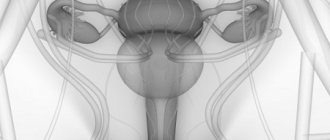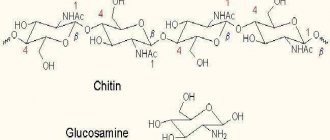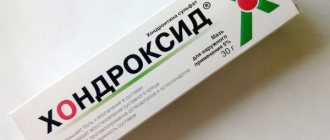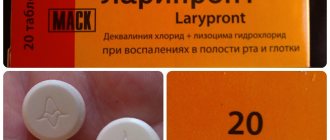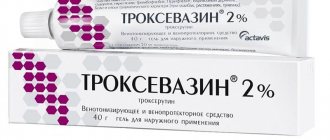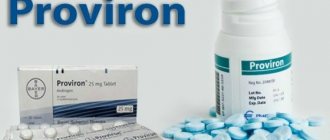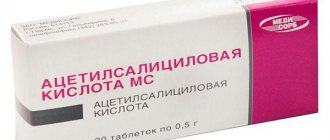Release forms and composition of the drug
Chondroitin sulfate is a medicine whose price is affordable for most consumers with average incomes. The table lists the main forms of release of this drug that can be used for therapeutic purposes.
| Release forms | Distinctive features |
| Pills | Tablets are one of the most popular forms of Chondroitin sulfate. The drug is packaged in plastic blisters or special containers. The main packaging of the medicine is a box made of thick cardboard. 1 pack of this medicine contains 30 or 60 tablets with the active substance in the form of chondroitin sulfate. Each package of the medicine is equipped with detailed instructions for its use. |
| Injection | 1 ampoule (2 ml) of a liquid transparent solution of Chondroitin sulfate contains 100 mg of the active substance. 1 pack of medication contains 10 doses of the drug, which are contained in a plastic container. The main packaging of the drug is a cardboard box. The average price of Chondroitin sulfate in injection form is 1100 rubles. for 10 ampoules. |
| Gel | Transparent gel is one of the forms of release of the drug Chondroitin sulfate, which is intended for external use. The drug has a thick base, is quickly absorbed into the skin after application, and the concentration of the active substance is 5%. Chondroitin sulfate gel is contained in plastic tubes of 30 mg. The drug is packaged in a rectangular cardboard box. The average cost of a medicine is 370-390 rubles. |
Chondroitin sulfate tablets
Chondroitin sulfate are tablets (the price of the drug is affordable for most consumers), the component of which is a chemical compound with high biological activity, sodium chondroitin sulfate. This substance is completely safe for the human body, and its concentration in 1 tablet of the drug is 500 mg.
Composition of the drug and release form
The active ingredient of all drugs is chondroitin sulfate, but each time it has its own dosage. Auxiliary components depend on the release form. Chondroitin sulfate is produced:
- for oral administration – capsules, tablets, powder (sachet);
- for external use – ointment, gel;
- for injections - lyophilisate powder, solution for injection.
The composition of the drug depends on the form of release:
- Chondroitin lyophilisate in ampoules. Contains Chondroitin sulfate 100 mg.
- Tablets and capsules. Active substance – 250 mg. Auxiliary components in tablets are calcium stearate, lactose. The capsules contain propylparaben, sodium lauryl sulfate, methylparaben, titanium dioxide, gelatin, water.
- Ointment and gel. Active ingredient – 5 g, auxiliary ingredients – macrogol glyceryl hydroxystearate, neroli oil, orange, lavender, trolamine, carbomer, nipagin, disodium edetate, dimexide, propylene glycol, purified water.
Pharmacological properties
By its nature of origin, Chondroitin sulfate tablets are a high molecular weight mucopolysaccharide that has the following pharmacological properties:
- participates in the restoration of the damaged structure of cartilage and bone tissue of the musculoskeletal system;
- improves metabolic processes in the body associated with the absorption of calcium and phosphorus salts, which is extremely important for building a strong skeleton;
- slows down age-related and degenerative changes in the structure of bone and cartilage tissue (this property of the drug is especially useful in the treatment of inflammatory diseases of the joints);
- prevents compression pinching of connective tissues of the musculoskeletal system;
- has a pronounced analgesic effect, reducing pain in bones and joints;
- stabilizes metabolic processes in hyaline tissue;
- neutralizes enzyme substances that disrupt the functional activity of articular cartilage;
- reduces the rate of calcium loss in patients suffering from osteoarthritis;
- has a local anti-inflammatory effect.
Regular use of Chondroitin sulfate tablets reduces the need for additional therapy with non-steroidal anti-inflammatory drugs. The pharmacological properties of the drug appear only if the rules of the course of treatment are followed.
If necessary, the attending physician may prescribe taking Chondroitin sulfate in combination with other potent chondroprotectors.
Chondroitin sulfate – biological role and advisability of taking it
Chondroitin sulfate is a polymeric glycosaminoglycan in sulfated form. Chondroitin is a component of cartilage and ligaments; it increases their compressive and tensile strength. It is reproduced by cartilage tissue and is one of the main components in the formation of synovial fluid (this biological fluid fills the joint cavity, reducing friction between bone elements).
Chondroitin is formed in cartilage with the direct participation of glucosamine; if it is not enough in the body, the synovial fluid loses its elasticity, as a result of which the bone elements in the joint begin to rub against each other. This leads to a crunching sound when the joint moves, and over time, to damage and pain. Functions of chondroitin in the human body:
- – chondroitin stimulates the reproduction of hyaluronic acid, which is responsible for strengthening the connective tissue structures of cartilage, ligaments and tendons;
- – chondroitin activates the function of sulfur retention during the formation of chondroitin-sulfuric acid, this leads to calcium retention in bone tissue;
- – chondroitin directly stimulates the regeneration of cartilage tissue, the substance has an anti-inflammatory and analgesic effect;
- – chondroitin has the property of conserving water in special water cavities of cartilage, this effect stimulates the stability of connective tissue, increasing its shock-absorbing property and ability to absorb shocks;
- – chondroitin has the property of inhibiting the activity of enzymes that have a destructive effect on connective tissue (these are lysosomal and some other enzymes).
Chondroitin enters the body through consumption of animal cartilage, tendons and skin (including fish products). Modern people often experience chondroitin deficiency for a number of reasons:
- – absence in the diet (or complete exclusion) of products containing the target substance;
- – individual metabolic disorders (including congenital and acquired pathological conditions);
- – increased physical activity in the context of strength training or heavy physical work;
- – also, the need for chondroitin increases with age due to a decrease in the activity of the corresponding synthetic processes.
Chondroitin can be recommended for use by professional athletes (bodybuilders and powerlifters), people who have given up eating meat and fish, and anyone who experiences impaired cartilage functionality. Chondroitin is not a pharmaceutical drug; it cannot be used to treat pathologies or replace targeted drugs prescribed by a specialist. However, due to its natural biological properties, the supplement can be an excellent addition to the daily diet in order to strengthen the cartilage and ligamentous apparatus.
Pharmacodynamics and pharmacokinetics
The pharmacodynamics of Chondroitin sulfate tablets is determined by the active component included in its composition. After ingestion, the drug is absorbed by the intestinal walls, and its main substance reaches the diseased area of the musculoskeletal system along with the bloodstream.
Chondroitin sulfate takes an active part in the construction of areas of cartilage tissue that have been destroyed as a result of an inflammatory or degenerative process. This primarily concerns the joints of the upper and lower extremities.
At the same time, the biochemical activity of enzymes is suppressed, the action of which leads to the destruction of cartilage tissue. Chondroitin sulfate reduces the inflammatory process and prevents further joint degeneration.
The chondroprotective properties of the drug make it possible to achieve the effect of gradual restoration of bone and cartilage tissue, as well as reduce the severity of pain. Patients taking the medication on an ongoing basis note an improvement in the mobility of the joints of the upper and lower extremities.
The pharmacokinetic properties of Chondroitin sulfate tablets were established based on the results of clinical studies of the drug. After a single therapeutic dose, the maximum concentration of the active substance in the blood plasma is achieved after 3-4 hours.
Inside the synovial fluid of the joints of the upper and lower extremities, the highest level of chondroitin sulfate is observed after 4-5 hours. The bioavailability of the drug is about 13%.
Metabolism of the active component of the drug occurs in the liver tissue, and the release of its products after the half-life occurs along with urine. At least 90% of metabolites are eliminated from the body by the kidneys.
This organ of the excretory system bears the main burden of removing drug residues. This pharmacokinetic property of the drug should be taken into account by people who have chronic kidney disease associated with impaired functional activity.
What is chondroitin
This substance is a component produced by the cartilage tissue of human joints. Chondroitin sulfate is a component of synovial fluid. This substance plays an important role in the functioning of the body’s skeletal system:
- regulates metabolic processes in cartilage cells;
- promotes the synthesis of hyaluronic acid;
- participates in the process of calcium deposition in bones.
Chondroitin is a chondroprotector, helps strengthen ligaments and tendons, and has a strong analgesic and anti-inflammatory effect. This substance:
- provides shock absorption when moving;
- promotes bone tissue regeneration;
- increases functional mobility of the joint capsule;
- inhibits the process of degeneration;
- improves the properties of synovial fluid;
- Helps restore the cartilage surface of joints.
What do they get it from?
The drug Chondroitin sulfate is made from bone marrow, tendons, skin, and cartilage. The working material is animals and fish. Depending on the base, the substance differs in purity, characteristics, bioactivity, and formulas. Low molecular weight fractions are obtained from salmon fish. The composition isolated from animals has less biological activity. Cartilage is used to make the drug:
- cattle;
- pigs;
- spiny sharks - katrans;
- sturgeon fish;
- stingrays;
- salmon;
- salmon
What are glucosamine and chondroitin for?
Small amounts of these two substances, necessary for normal joint function, are produced by the body. Partially they come from food - they are present in beef, hard cheeses, and poultry. Substances included in dietary supplements. Glucosamine sulfate in the body is intended to produce hyaluronic acid, building the chondroitin molecule. This substance helps:
- synthesis of articular cartilage;
- strengthening metabolic processes;
- increasing joint mobility;
- improving cartilage nutrition;
- pain relief;
- slowing down the leaching of calcium from bones.
The difference between chondroitin is its ability to suppress enzymes formed during diseases and injuries. These substances contribute to the destruction of cartilage. Uses of Chondroitin sulfate:
- activates the formation of synovial fluid;
- inhibits the destruction of bone cartilage cells;
- reduces pain when moving;
- relieves inflammation of joint capsules;
- increases the mobility of affected joints;
- improves calcium-phosphorus metabolism in connective tissues;
- stimulates the synthesis of hyaluronic acid.
Indications for use
Chondroitin sulfate - tablets (the price of the medicine depends on the conditions of the pharmaceutical market), which are indicated for use for therapeutic purposes for the treatment of the following diseases of the musculoskeletal system:
- degenerative-dystrophic diseases of the spine and joints;
- periodontitis, which is in the acute stage (the drug is also used to treat the chronic form of this disease);
- bone fracture, regardless of the location of the injury (the active component of the tablets allows you to speed up the process of tissue regeneration and restore body mobility);
- chronic osteochondrosis of the spine;
- rehabilitation period after injuries to the musculoskeletal system or previous surgical interventions;
- all types of arthrosis;
- progressive osteoporosis without signs of pathological damage to bone integrity;
- intervertebral osteochondrosis;
- inflammatory diseases of the joints of unspecified etiology.
The prescription of taking Chondroitin sulfate tablets should only be carried out by the attending physician who has performed a preliminary examination of the patient and has also determined the advisability of using this particular medication. The duration of therapy is determined individually.
Contraindications
Chondroitin sulfate tablets are completely safe for the human body.
Despite this, their use is strictly contraindicated for people who have the following diseases, as well as pathological conditions of internal organs and systems:
- individual intolerance to the active substance chondroitin sulfate, which manifests itself in the form of allergic reactions (itching of the skin surface, rashes, redness of epithelial tissues, swelling of the mucous membranes, urticaria);
- functional disorders in the kidneys and liver, which do not allow for complete metabolism of the substance chondroitin sulfate;
- hematological diseases associated with changes in the cellular composition of the blood and a violation of its coagulation (in this case, the risk of internal bleeding increases);
- thrombophlebitis and other painful vascular conditions accompanied by the formation of blood clots.
The use of the drug during pregnancy or breastfeeding of a newborn child is possible only after prior consultation with the attending physician, as well as an assessment of the potential risks and possible benefits. Depending on the individual characteristics of the patient’s health, the doctor may discover other factors that exclude therapy with Chondroitin sulfate tablets.
Reviews
Reviews about Chondroitin sulfate can be found on medical forums. Doctors and patients respond positively to the medicine .
The authors of negative reviews are people with individual intolerance to the active component. They had to refuse treatment due to skin itching, urticaria and other allergic reactions that arose during therapy.
Patients with good tolerance to the drug received 2 to 3 courses of treatment per year. In the intervals between injections, they were prescribed chondroprotectors for oral use.
This therapy allowed us to obtain good results: reduction of pain and crunching, improvement of joint mobility. Subjective improvements were confirmed by improved radiographic parameters.
You can study reviews of real people about chondroitin sulfate at the end of this instruction. If you or your loved ones have already been prescribed medications based on this substance, please leave your review of the treatment.
Instructions for use, dosage
Chondroitin sulfate is a tablet (the price of the medication does not exceed the average), which are intended for course use over a long period of time.
At the initial stage of therapy, the medication is prescribed in a dosage of 1 tablet 3 times a day, which is taken after meals. The drug must be taken with a sufficient amount of plain water. The duration of the initial course of treatment is 3 weeks.
After the specified period of time, the dosage of the drug is reduced to 1 tablet 2 times a day. It is recommended to take the drug in the morning and evening at the same time of day.
The duration of further therapy is 2-3 months. depending on the type and severity of the musculoskeletal system disease. In this case, the attending physician can adjust the final dosage and duration of treatment with Chondroitin sulfate tablets.
Methods of use and dosage of chondroitin
The daily dose of Chondroitin sulfate is 800-1200 mg. If the doctor has prescribed a product with a high concentration of the active substance, then during the first three weeks it is recommended to take it in the morning, at lunch and before bed. Next, the dose should be reduced and the number of doses reduced to two.
To prevent joint pain, the complex is prescribed at a dose of 800 mg per day for a monthly course. Therapy should be carried out twice a year, and repeated after a break, the period of which is determined by the doctor. For pain in the joints or regular sprains, the daily amount of medication is increased to 1200 mg. The course of treatment should be at least 2 months, with a break of 30 days. Within a year, you need to repeat this therapy three times.
It is necessary to take glucosamine chondroitin orally before meals. In patients over 15 years of age and adults, the regimen is as follows: 2-3 times a day, 2 capsules. Duration of therapy is 1-2 months.
Ointment or gel products are used in elderly patients. They should be applied in a thin layer to the damaged area at least three times a day. Depending on the diagnosis, treatment can last from two weeks to three months. A second course of therapy is permitted no earlier than six months later.
Side effects
After oral administration of Chondroitin sulfate tablets, the development of the following side effects caused by the pharmacological properties of the main component cannot be excluded:
- attacks of spasmodic pain in the epigastric part of the stomach;
- flatulence and increased gas formation in the intestines;
- Strong headache;
- itching and rash of the skin surface, erythema, urticaria, swelling of epithelial tissues and mucous membranes, dermatitis of an allergic nature, the presence of which indicates individual intolerance to this drug;
- general physical weakness;
- drowsiness during the daytime, as well as insomnia at night;
- rapid fatigue that appears after minor physical exertion;
- loss of appetite;
- dizziness and loss of coordination of movements;
- nausea accompanied by vomiting;
- diarrhea or constipation (the presence of these symptoms indicates dysfunction of the gastrointestinal tract).
If the above-mentioned adverse reactions occur after taking Chondroitin sulfate tablets, it is necessary to stop further therapy with these drugs.
It is also recommended to seek additional advice from the doctor who prescribed treatment with this medication. If signs of an allergic reaction occur, you may need to take antihistamines.
Side effects and contraindications
Medicines for the treatment of bones and joints should be used only as prescribed by a doctor. This is due to the presence of contraindications for use. It is prohibited to use funds for:
- individual intolerance to the components of the drug;
- allergic reactions to seafood;
- bleeding tendency;
- diabetes mellitus;
- dysfunction of the liver, kidneys;
- thrombophlebitis.
In case of an overdose of the drug, side effects of the drug cannot be ruled out. Possible hemorrhage at the injection site. The following phenomena are observed:
- from the nervous system - weakness, dizziness, high fatigue, sleep disturbances, headache;
- allergic reactions - rashes, swelling, itching, burning, dermatitis, urticaria;
- from the gastrointestinal tract - nausea, constipation, vomiting, flatulence, diarrhea.
Overdose
Violation of the drug dosage rules can lead to an overdose, which is expressed by signs of general intoxication of the body.
The patient has the following symptoms:
- various allergic reactions, which are most often expressed in the form of dermatitis, erythema, urticaria, red rash, swelling and itching of epithelial tissues;
- feeling of cutting pain in the area of the stomach;
- bloating and increased gas formation;
- feeling of nausea and vomiting;
- dizziness, physical weakness and decreased blood pressure;
- diarrhea;
- Strong headache;
- fast fatiguability;
- loss of appetite.
In case of an overdose, the patient is prescribed symptomatic treatment, which consists of gastric lavage, as well as taking sorbent preparations. Before the ambulance arrives, the patient must be provided with complete rest and plenty of fluids. If there is nausea and the urge to vomit, the person should be placed on his side, placing a high pillow or a roll made of clothing under his head.
Performing these actions will prevent vomit from entering the respiratory system. As sorbent preparations, you can use 8-10 tablets of Activated Carbon, 1 packet of Atoxil or 1 tbsp. l. Enterosgel. To receive further symptomatic therapy, the patient is hospitalized in the toxicology department.
special instructions
To avoid overdose or side effects, it is recommended not to violate the instructions for use of the medication. If necessary, Chondroitin sulfate tablets are allowed to be included in the general course of combination therapy with drugs belonging to the pharmacological group of glucocorticosteroids and non-steroidal anti-inflammatory drugs.
In this case, a more pronounced anti-inflammatory and restorative effect is achieved. During treatment with Chondroitin sulfate tablets, drinking alcoholic beverages should be avoided.
Simultaneous consumption of alcohol increases the load on the tissues of the liver and kidneys. Clinical trials of the drug have not confirmed the ability of the active substance of Chondroitin sulfate tablets to influence the speed of psychomotor reactions, reduce concentration or have any other effect on the functions of the central nervous system.
If you experience signs of dizziness, drowsiness, or a sudden loss of strength, you should temporarily refrain from driving vehicles, equipment and mechanisms that require increased concentration and quick reaction. These recommendations also apply to high-risk work.
Chondroitin sulfate - instructions for use
The annotation for the medicinal product stipulates the dosage features for each form. There are important points to consider during use. The instructions recommend:
- If side effects occur, stop treatment and consult a doctor;
- do not use the product for external use in the presence of open injuries or damage to the skin;
- if there is no improvement within two weeks, the medicine must be changed;
- Avoid contact of ointment or gel with the mucous membranes of the eyes.
Chondroitin injections intramuscularly
The use of the drug in injections involves mixing the powder from one lyophilisate ampoule with 1 ml of water intended for injection. The course of treatment is determined by the doctor, and the dosage is increased under his control. There are features of use:
- the medicine is administered intramuscularly;
- the course is up to 35 injections every other day;
- if necessary, the drug is well tolerated by the patient, after the fifth injection the dosage can be increased to 2 ml;
- It is recommended to repeat the course of treatment after six months.
Tablets for oral administration
Instructions for use specify the specifics of using the medicine in tablet form. It is important to follow the dosage prescribed by your doctor to avoid side effects. Recommended tablets and capsules:
- use orally with plenty of water;
- swallow the capsule whole;
- intake does not depend on food intake;
- tablets can be chewed;
- For children, pour the contents of the capsule into milk, juice, or water.
The doctor sets the dosage and duration of the course individually, depending on the course of the disease and its severity. The instructions give the following recommendations:
- the duration of treatment ranges from 20 days to three months;
- re-use of the medicine after six months;
- The daily dosage for children is 250 mg, for adults – 750 mg twice.
- Idaho Potatoes: Recipes
- Thirty-third week of pregnancy
- Vitamin PP - what is it for? What products contain nicotinic acid and instructions for use
Chondroitin ointment for external use
For periodontopathy in dentistry, the use of ointments and gels is practiced for the treatment of joint ailments. Please note that the medicine should not be applied to open wounds. Do not use for damaged skin or mucous membranes. Medicine, according to instructions:
- applied to the affected area three times a day;
- rubbed into the surface in a circular motion;
- The course duration ranges from two weeks to three months - depending on the diagnosis;
- Therapy can be repeated after six months.
Drug interactions
The combined use of Chondroitin sulfate tablets with antibacterial spectrum drugs, which belong to the category of tetracyclines, enhances the absorption of the latter in the gastrointestinal tract.
At the same time, the absorption of semisynthetic penicillins and chloramphenicol-based medications decreases. Chondroitin sulfate is approved for simultaneous use with non-steroidal anti-inflammatory drugs and glucocorticosteroids. This combination therapy reduces the need for additional pain medications.
To increase the overall therapeutic effectiveness of Chondroitin sulfate tablets, it is recommended to combine them with vitamin A, ascorbic acid, and mineral supplements containing zinc salts, potassium permanganate, magnesium and copper.
With simultaneous treatment with indirect anticoagulants, blood clotting may be disrupted, which requires more careful monitoring by the attending physician. Chondroitin sulfate is able to enhance the pharmacological properties of fibrinolytics and antiplatelet drugs.
In the case of joint therapy with medications that can affect the degree of blood clotting, it is necessary to monitor platelet counts.
Instructions for use
pharmachologic effect
Chondroitin sulfate has chondrostimulating and chondroprotective effects. It is a mucopolysaccharide that is part of the cartilage matrix along with collagen fibers. Participates in the construction of cartilage and bone tissue.
Suppresses the activity of enzymes that disrupt the structure of cartilage, which leads to inhibition of degeneration processes.
Provides restoration of the cartilaginous surface of the joint , normalization of the production of intra-articular fluid. The result is an increase in joint mobility, a slowdown in the progression of osteoarthritis, and a reduction in pain and discomfort.
The drug has analgesic and anti-inflammatory properties, reduces pain at rest and when walking, and reduces the need for non-steroidal anti-inflammatory drugs.
Release form, composition
The medicine can be available in the form:
- tablets, capsules for oral use;
- lyophilisate for preparing an injection solution;
- ointments.
Each dosage form contains the same active ingredient - chondroitin sulfate .
Indications for use
Indications for use of the drug are:
- Degenerative dystrophic changes in joints (including the spine). The medicine can be used for osteochondrosis and deforming arthrosis. Most often it is used for diseases of large joints (knees, shoulders, elbows, hips).
- Periodontopathy is a pathology associated with damage to periodontal tissue. The medicine is prescribed for dystrophic, inflammatory, mixed forms of the disease. It is also used for periodontopathy of unknown origin, accompanied by destruction of the tissues of the lower or upper jaw.
- Osteoporosis (including those caused by damage to large joints and long-term use of glucocotic steroid drugs).
- Deforming spondylosis of the spine.
- Bone injuries. The medicine ensures rapid fusion of bones and restoration of working capacity in the shortest possible time.
Directions for use, dosage
The procedure for using the medicine depends on the form of release.
Lyophilisate for injection
The contents of 1 ampoule are mixed with 1 ml of water for injection. The medicine is administered intramuscularly, 1 ml every two days. Starting from the 4th injection, the dosage can be increased to 2 ml, but only with the doctor’s permission. One course of treatment takes about 25-35 injections. Repeating the course is possible no earlier than after 6 months.
Capsules, tablets for oral administration
Chondroitin sulfate is taken at any time of the day, regardless of meal time. Take the medicine with a sufficient volume of liquid. When treating children under 1 year of age, the contents of the capsules are mixed with water, tea or milk.
The daily dosage depends on the patient’s age:
- children under 12 months – 250 mg;
- children aged 1-5 years – 500 mg;
- children, adolescents aged 5-16 years – 500-750 mg;
- adults – 1500 mg.
The duration of therapy varies from 3 to 12 weeks.
Interaction with other drugs
Chondroitin sulfate for oral use can enhance the effect of anticoagulants, indirect coagulants, fibrinolytics.
Analogs
The following drugs are presented on the pharmaceutical market, which are available in the form of tablets, ointments and intramuscular injections, have chondroprotective, anti-inflammatory and analgesic properties, and are also analogues of the drug Chondroitin sulfate:
- Chondroguard;
- Drastop;
- Structum;
- Art traffic;
- Chondrolone;
- Mucosat;
- Artra Chondroitin;
- Artradol;
- Artogistan;
- Khonsurid;
- Artrin;
- Chondroitin sulfate-Travium.
The prescription of analogue drugs should be carried out only by the attending traumatologist or surgeon after a preliminary examination of elements of the musculoskeletal system that require anti-inflammatory and restorative therapy.
Terms, conditions of sale and storage
The tablet form of the drug Chondroitin sulfate should be stored in the manufacturer’s original packaging at an ambient temperature not exceeding +25 degrees. The medication should be placed in a dark, cool place out of the reach of children.
The maximum shelf life of the chondroprotective agent is 3 years, after which further use of the tablets is prohibited. To purchase Chondroitin sulfate tablets, you do not need to present a special doctor's prescription.
Price
The average cost of Chondroitin sulfate tablets in retail pharmacy chains is 655 rubles. The price of a drug may vary depending on factors in the pharmaceutical market and the internal policies of pharmacy management.
Chondroitin sulfate tablets are an effective medicine that belongs to the category of long-acting chondroprotectors.
The drug is indicated for use by adult men and women who suffer from osteoarthritis, degenerative and inflammatory diseases of the spine, chronic osteochondrosis, periodontitis, osteoporosis, and metabolic disorders of calcium and phosphorus salts.
Chondroitin sulfate tablets can also be prescribed to patients who are recovering from a bone fracture, damage to cartilage tissue, or previous surgery. The average duration of treatment with this drug is at least 2-3 months, and the price of the medication is within 655 rubles. per package.
